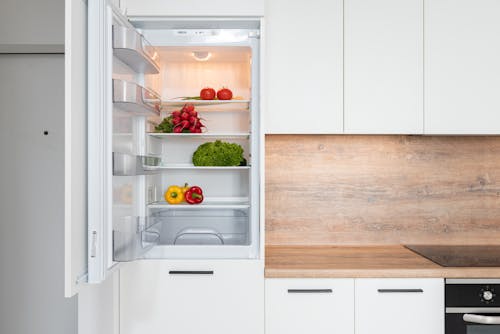Your refrigerator is one of the hardest-working appliances in your home, tirelessly keeping your food fresh and safe to eat day in and day out. With proper care and maintenance, you can extend the lifespan of your fridge and ensure it continues to operate efficiently for years to come. In this blog post, we’ll explore preventive maintenance strategies and practical tips to help you maximize the lifespan of your refrigerator, saving you money on repairs and replacements in the long run.
- Keep It Clean:
- Regular cleaning is essential for keeping your fridge in top condition. Wipe down the interior surfaces, shelves, and drawers with a mild detergent and warm water to remove spills, stains, and food residue.
- Pay attention to the door seals, or gaskets, which can accumulate dirt and grime over time. Clean the seals regularly with a damp cloth to maintain a tight seal and prevent air leaks.
- Check and Replace Door Seals:
- The door seals play a crucial role in maintaining the temperature inside your fridge and preventing cold air from escaping. Inspect the seals regularly for signs of wear, damage, or deterioration.
- If you notice any cracks, tears, or gaps in the seals, it’s time to replace them. Damaged door seals can lead to energy loss and cause your fridge to work harder to maintain the desired temperature, leading to increased energy consumption and wear on the compressor.
- Keep the Coils Clean:
- The condenser coils, located either on the back or underneath your fridge, are responsible for dissipating heat from the refrigerator’s interior. Over time, dust, dirt, and pet hair can accumulate on the coils, hindering their ability to dissipate heat efficiently.
- Vacuum or brush the coils regularly to remove dust and debris. This simple maintenance task can help prevent overheating and prolong the lifespan of your fridge’s compressor.
- Maintain Proper Temperature Settings:
- Keeping your fridge at the right temperature is essential for preserving food freshness and preventing spoilage. Most refrigerators should be set between 37°F and 40°F (3°C and 4°C) to maintain optimal food storage conditions.
- Use a refrigerator thermometer to monitor the temperature regularly and adjust the settings as needed. Avoid overfilling the fridge, as overcrowding can obstruct airflow and compromise cooling efficiency.
- Don’t Overload the Door Shelves:
- The door shelves are convenient for storing condiments, beverages, and other small items. However, overloading the door shelves with heavy items can strain the door hinges and cause them to become misaligned or damaged.
- Distribute the weight evenly across the door shelves and avoid placing heavy items, such as gallon jugs or jars, on the top shelf. This will help prevent excessive stress on the door mechanism and extend its lifespan.

- Level Your Fridge:
- A refrigerator that is not level can cause the doors to close improperly, leading to air leaks and energy loss. Use a level to check the alignment of your fridge and adjust the leveling legs as needed to ensure it sits evenly on the floor.
- Periodically check the alignment of the doors and make any necessary adjustments to ensure they seal tightly when closed. Proper door alignment will help maintain consistent temperatures inside the fridge and freezer compartments.
- Avoid Placing Hot Food in the Fridge:
- Placing hot or warm food directly into the fridge can raise the internal temperature and put extra strain on the compressor as it works to cool the food down.
- Allow hot foods to cool to room temperature before placing them in the fridge. This will help maintain the desired temperature inside the fridge and reduce energy consumption.
- Clean the Drip Pan and Drain Line:
- The drip pan and drain line are responsible for collecting and removing excess moisture from the refrigerator during the defrosting process. Over time, the drip pan can become dirty or clogged with debris, leading to odors and potential water damage.
- Remove the drip pan and clean it with warm, soapy water to remove any buildup. Use a pipe cleaner or small brush to clear any debris from the drain line to ensure proper drainage and prevent water backup.
- Check the Ice Maker and Water Filter:
- If your fridge is equipped with an ice maker or water dispenser, regular maintenance is essential to ensure proper function and water quality.
- Clean the ice maker and water dispenser regularly according to the manufacturer’s instructions. Replace the water filter as recommended to maintain water purity and prevent clogs or malfunctions.
- Schedule Professional Maintenance:
- While many maintenance tasks can be performed by homeowners, some repairs and maintenance tasks are best left to professionals.
- Schedule annual or biannual maintenance appointments with a qualified appliance technician to inspect your fridge, clean internal components, and address any potential issues before they escalate into major problems.
Conclusion: By following these preventive maintenance strategies, you can extend the lifespan of your refrigerator and ensure it continues to operate efficiently for years to come. From keeping it clean and maintaining proper temperature settings to checking and replacing door seals and cleaning the condenser coils, these simple yet effective tips can help you maximize the performance and longevity of your fridge. By investing a little time and effort in preventive maintenance, you can avoid costly repairs and replacements and enjoy fresh, safe food storage for your family.
